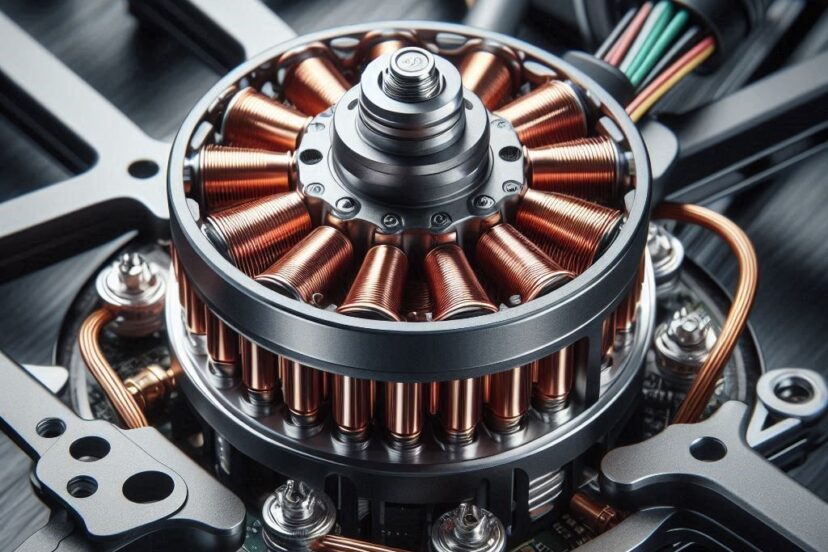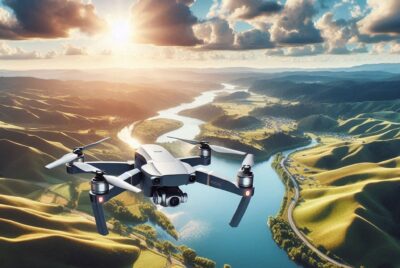Heavy Lift Drone Motors: Power Up Your Aerial Capabilities
*We may earn a commission for purchases made using our links. Please see our disclosure to learn more.
Heavy Lift Drone Motors: Key Innovations and Trends
Drones have become powerful tools in many fields, transforming tasks from aerial photography to package delivery. A crucial element that determines a drone’s capability is its motor. For those needing to transport heavy loads, heavy lift drone motors are essential. These motors are designed to handle increased weight, allowing drones to carry substantial payloads safely and efficiently.
When selecting a heavy lift drone motor, it’s important to focus on several key factors. The motor’s thrust capacity needs to match or exceed the weight you plan to lift. Additionally, efficiency and power consumption can affect how long the drone can stay airborne. Durability and build quality are also crucial, ensuring the motor withstands the rigors of heavy lifting.
Choosing the right motor involves careful consideration of these factors to achieve optimal performance. I have spent a lot of time evaluating different models to guide you to the best options available.
Top Heavy Lift Drone Motors
I’ve researched and chosen the top heavy lift drone motors for this list. These options provide great performance and reliability for drone enthusiasts and professionals alike.
SpeedyBee 2306.5 Drone Motor
If you’re in need of a smooth, reliable motor for your FPV drone, the SpeedyBee motor is definitely worth considering.
Pros
- Delivers smooth and stable flight
- Quick and easy to install
- Offers enhanced dynamic balance
Cons
- Quality control issues reported
- A bit pricey for the performance
- One motor may not function as expected
Recently, I had the chance to try out the SpeedyBee 2306.5 motors. I found them to be incredibly smooth during both flight and shooting, which is crucial when capturing steady footage. The integrated outer rotor helps with dynamic balance, making my drone operations steady.
Installation was a breeze, and I appreciated how quickly I was able to get these motors up and running. This convenience is a big plus for anyone wanting to swap out old parts without much downtime.
However, I did notice some inconsistencies in quality control. One of my motors didn’t spin properly. While this was a minor hiccup, it’s something to be aware of if you’re considering these for serious projects. Overall, the motors are a solid choice, but check them on arrival.
iFlight XING 2806.5 Motors
For anyone venturing into the world of powerful drone builds, these motors could be a solid choice with their impressive performance and features.
Pros
- Strong and responsive thrust for demanding flights
- Smooth and quiet operation, even at high speeds
- Reliable with excellent build quality using Japan NSK bearings
Cons
- Potential reliability issues with some units not functioning
- Might require careful handling due to size
- Not suitable for beginners due to high power demands
I recently got a chance to try out the iFlight XING 2806.5 motors. As soon as I unpacked them, their size was immediately impressive, and spinning them by hand felt incredibly smooth. When flying with them, I noticed how they quickly delivered the power needed for challenging maneuvers.
These motors shined on my 7-inch long-range quad. The stability they provided was top-notch, allowing for smooth cruising and responsive controls. I could easily hit speeds up to 90mph, which made my flights exhilarating. The quiet nature of these motors was a bonus, especially for those who appreciate a less noisy flight experience.
Despite the high points, one of the motors didn’t work on a different build, highlighting a potential issue. It’s a small drawback in an otherwise robust product, but something to be aware of if you decide to use them in your next build. Overall, these motors are a great choice for experienced builders looking to add real power to their quads.
iFlight XING2 2207 Motor
These motors are ideal for anyone looking to enhance their drone’s performance with smooth, efficient power.
Pros
- Excellent build quality with crash-resistant materials
- Smooth and stable flying experience
- Reduction in motor noise due to O-Ring Bearing
Cons
- Some users experience issues with motor durability
- Requires careful installation to avoid damage
- Propeller not included
I recently tried out the iFlight XING2 2207 motors, and I was impressed with their power and smooth operation. The first few flights were smooth, and the efficiency boost was noticeable, providing me with an extra minute of flight time. The new center-slotted magnets made the drone more responsive, which I really appreciated.
In terms of build, the motors feel robust, thanks to the titanium alloy shaft and 7075 aluminum bell. These materials withstand crashes better than many other options I’ve tested. However, I was careful during installation to ensure everything was mounted properly, speaking to the importance of handling these high-quality components with care.
Though one downside might be the lack of an included propeller, it’s a minor issue if you have specific propellers in mind. Overall, I found these motors to be a great addition to any drone setup, offering that sought-after balance of power and efficiency.
SUNFUN 2306 Brushless Motor
This motor is a reliable choice for those looking to upgrade their drone’s performance with more power and efficiency.
Pros
- Excellent power output for heavier drones
- Lightweight design increases overall flight efficiency
- High torque for better maneuverability
Cons
- May generate more heat during extended use
- Requires specific propeller sizes
- Limited to certain drone sizes due to compatibility
I recently had the chance to try out the SUNFUN 2306 motor, and I was impressed with its power. It really boosts my drone’s performance when I need to lift heavier loads. The 12N14P design delivers strong thrust, making it much easier to handle challenging flights.
The light weight helps with maintaining flight efficiency, which means my drone stays in the air longer without compromising speed or agility. The motor runs smoothly and consistently, contributing to a more enjoyable flying experience. However, it does get a bit warm after long flights, which is something I keep an eye on.
The motor is particularly suited to mid-sized drones, ensuring top-notch performance. I had to be careful with the propeller size, as using the wrong one could impact the motor’s effectiveness. Overall, though, it’s a sturdy and reliable component that has quickly become my go-to for making my drone flights more powerful and efficient.
Tarot TL68P07 Brushless Motor
A solid choice for heavy lift drones, though some motors show reliability issues.
Pros
- Strong build gives them excellent durability for demanding tasks.
- Affordable for hobbyists looking to expand their projects.
- Easy installation with quality mounting screws included.
Cons
- Occasional reliability issues with motor windings.
- Some motors may not fit all standard mounts perfectly.
- Slow shipping times might delay your project.
The Tarot TL68P07 motors impressed me with their beefy construction and robust performance. After trying these on my latest drone project, I noticed they provided the kind of power that makes lifting hefty payloads manageable. Each motor’s solid design reassured me of its durability during flight.
These motors come with affordable pricing, which is a bonus for those building or upgrading their quadcopters. The installation process was straightforward, and the included quality mounting screws made setup even easier.
While there are strong points, I did encounter a few snags. Some motors had winding issues, leading to potential burnouts, which was concerning. Fitting them onto a standard mount required some adjustments to ensure they were secure. Plus, the slower shipping might be something to consider if you’re on a tight schedule.
Buying Guide for Heavy Lift Drone Motors
When choosing heavy lift drone motors, I focus on a few key factors to make the best decision. The first thing I look for is power and efficiency. I want a motor that provides enough thrust but also uses energy wisely to ensure long flight times.
Weight Capacity is another important factor. I need to know how much weight the motor can lift without problems. This helps in selecting the right motor for my specific needs. It’s good to check detailed specifications to find this information.
I pay attention to the motor’s size and weight too. A heavier motor might affect the drone’s performance, so I aim for a balance between size and power. Smaller, lighter motors can still provide great efficiency for certain tasks.
| Feature | Importance |
| Power Efficiency | High |
| Weight Capacity | High |
| Size & Weight | Medium to High |
Price is also something I can’t ignore. While I don’t want to overspend, it’s crucial to pick a motor that offers quality and durability. Comparing prices in relation to features helps me find the best deal.
It’s crucial to consider compatibility with my drone. I ensure that the motor fits well with the existing parts. This avoids issues during installation or while flying. I usually double-check the motor’s specifications against my drone’s requirements.
FAQs About Heavy Lift Drone Motors
I often get questions about heavy lift drone motors. People want to know how factors like motor specifications and RPM affect lifting power and how new technologies are changing the game. Here’s a closer look.
1. What factors determine the lifting capacity of a drone motor?
A few main factors decide how much a drone motor can lift. Motor size, power output, and torque are important. The motor’s efficiency and the type of battery used also play roles. These elements work together to handle heavy payloads.
2. How do drone motor specifications relate to payload capabilities?
Motor specifications tell us a lot about what a drone can carry. The motor’s thrust rating shows its lifting strength. Higher power motors allow for larger payloads. It’s important to match the motor’s capabilities with the drone’s intended use to ensure safety and efficiency.
3. What is the price range for heavy lift drone motors?
High-capacity drone motors have a wide price range. Basic models might start around a few hundred dollars. Top-end motors with advanced features can go up to several thousand dollars. The cost depends on factors like brand, power, and technology.
4. How do RPM and propeller size impact a drone’s lifting power?
RPM (Revolutions Per Minute) and propeller size affect how well a drone lifts. Higher RPM can mean faster speed, but it’s the combination with propeller size that matters. Larger propellers move more air, which can increase lift. Finding the right balance of RPM and propeller size is crucial.
5. What are the latest advancements in motor technology for large payload drones?
There are exciting advancements in motor technology for drones carrying large loads. New motors have increased efficiency and cooling systems. Innovations like brushless motors and improved materials offer better performance and lower weight. These developments allow for heavier payloads with less energy consumption.









